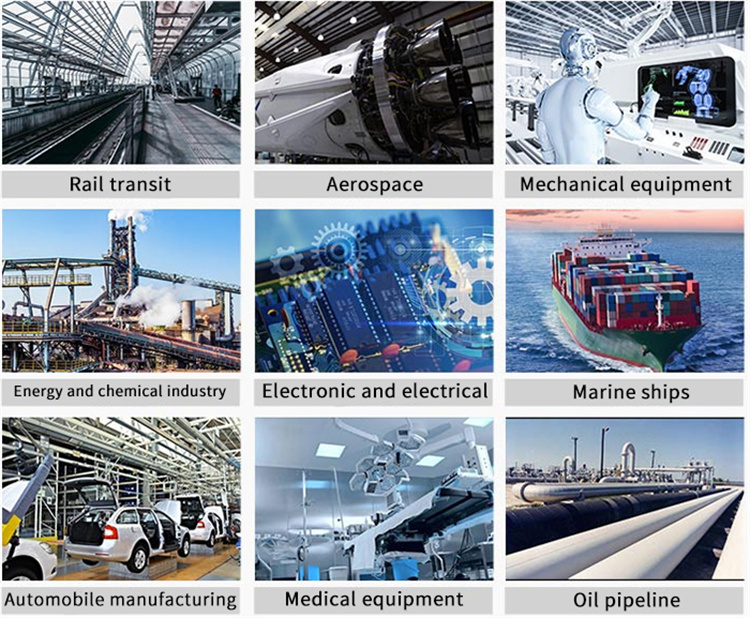
316 rustfritt stålrør tilhører austenittisk rustfritt stål. Denne typen rustfritt stål er oppkalt etter mikrostrukturen, som hovedsakelig består av austenittfase (ansiktssentrert kubisk krystallstruktur).
SS 316 rør er et austenittisk rustfritt stål, hvor hovedkomponentene inkluderer jern, krom, nikkel og molybden. Den er mye brukt for sin utmerkede korrosjonsbestandighet og høye temperaturytelse i kloridmiljøer.
316 rustfritt stålrør inneholder krom, som bidrar til å danne en passiveringsfilm på metalloverflaten. Denne filmen beskytter metallet mot korrosjon ved å forhindre at oksygen og vann kommer i kontakt med det underliggende metallet. Tilsetningen av molybden forbedrer også korrosjonsmotstanden til 316 rustfritt stålrør.
Kjemiske elementer:
Tilsetning av molybden gir 316 rustfritt stål utmerket motstand mot grop- og sprekkkorrosjon, spesielt i kloridmiljøer.
|
Klasse |
C |
Mn |
Si |
P |
S |
Cr |
Mo |
Ni |
N |
|
316 |
≤ 0.08 |
≤ 2.0 |
≤ 0.75 |
≤ 0.045 |
≤ 0.030 |
16.0-18.0 |
2.0-3.0 |
10.0-14.0 |
≤ 0.10 |
Mekaniske egenskaper:
Disse mekaniske egenskapene gir 316 ss rør utmerket stabilitet og holdbarhet i miljøer med høyt trykk og høye temperaturer.
|
Materiale |
Strekkfasthet |
Strekkgrense |
Forlengelse %, Min |
|
Ksi (MPa), min. |
Ksi (MPa), min. |
||
|
316 |
75 (515) |
30 (205) |
35 |
 Korrosjonsbestandighet: 316 rustfritt stålrør har utmerket korrosjonsbestandighet på grunn av 2-3% molybdenelementet, spesielt i miljøer som inneholder kloridioner, som sjøvann, sure og alkaliske løsninger i kjemisk industri, etc.
Korrosjonsbestandighet: 316 rustfritt stålrør har utmerket korrosjonsbestandighet på grunn av 2-3% molybdenelementet, spesielt i miljøer som inneholder kloridioner, som sjøvann, sure og alkaliske løsninger i kjemisk industri, etc.
 Mekaniske egenskaper: Den har høy strekkfasthet og flytestyrke, og har god duktilitet og seighet.
Mekaniske egenskaper: Den har høy strekkfasthet og flytestyrke, og har god duktilitet og seighet.
 Høytemperaturytelse: 316 rustfritt stål har god oksidasjonsmotstand og styrke ved høye temperaturer, kan opprettholde stabil ytelse og er egnet for høytemperaturmiljøer.
Høytemperaturytelse: 316 rustfritt stål har god oksidasjonsmotstand og styrke ved høye temperaturer, kan opprettholde stabil ytelse og er egnet for høytemperaturmiljøer.
 Bearbeidbarhet: 316 rustfritt stålrør har god bearbeidbarhet og kan formes og bearbeides ved kaldbearbeiding, varmbearbeiding, sveising og andre metoder for å møte ulike applikasjonskrav.
Bearbeidbarhet: 316 rustfritt stålrør har god bearbeidbarhet og kan formes og bearbeides ved kaldbearbeiding, varmbearbeiding, sveising og andre metoder for å møte ulike applikasjonskrav.
 Kjemisk industri:
Kjemisk industri:
316 rustfritt stålrør brukes hovedsakelig i utstyrsproduksjon i den kjemiske industrien, for eksempel reaktorer, lagringstanker, rørledninger, etc., på grunn av sin sterke korrosjonsmotstand og evne til å motstå erosjon av forskjellige syre- og alkaliløsninger.
 Medisinsk utstyr:
Medisinsk utstyr:
316 rustfritt stålrør brukes hovedsakelig i medisinsk utstyr, som kirurgiske instrumenter, implantater, etc., på grunn av dets gode biokompatibilitet og korrosjonsbestandighet.
 Mat- og drikkevareindustrien:
Mat- og drikkevareindustrien:
316 rustfrie stålrør oppfyller matsikkerhetsstandarder på grunn av deres korrosjonsbestandighet, enkle rengjøring og lave bakterievekst. De brukes hovedsakelig i meieribehandlingsutstyr, bryggeutstyr, etc.
 Aerospace:
Aerospace:
316 rustfrie stålrør brukes hovedsakelig til å produsere høystyrke, høykorrosjonsbestandige deler som drivstoffrørledninger, hydrauliske systemer, etc.
 Konstruksjon og dekorasjon:
Konstruksjon og dekorasjon:
316 rustfrie stålrør brukes hovedsakelig til å lage trapperekkverk, utvendig veggdekorasjon, landskapsteknikk, etc.

 Inspeksjon av fysisk ytelse:
Inspeksjon av fysisk ytelse:
Inspeksjon av fysisk ytelse inkluderer strekktesting, slagtesting, hardhetstesting, etc., for å evaluere styrken, seigheten og hardheten til 316 rustfrie stålrør.
 Kjemisk sammensetningsanalyse:
Kjemisk sammensetningsanalyse:
Kjemisk sammensetningsanalyse bruker utstyr som spektrometre og massespektrometre for å oppdage om sammensetningen av 316 rustfrie stålrør oppfyller standardkravene.
 Ikke-destruktive testmetoder:
Ikke-destruktive testmetoder:
Ikke-destruktive testmetoder inkluderer ultralydtesting, røntgentesting, etc., som kan oppdage defekter inne i 316 rustfrie stålrør og problemer med sveisekvalitet.

Inspeksjon av rustfrie stålrør er svært viktig. Vår fabrikk vil gjennomføre kvalitetskontroll på produktene før levering. Dette er ikke bare ansvarlig overfor kundene våre, men reflekterer også vår forpliktelse til å levere produkter av høy kvalitet.
 Hete nyheter
Hete nyheter
Copyright © Henan Jinbailai Industrial Co.,Ltd. Alle rettigheter reservert - Personvernerklæring